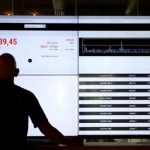U.S. bond yields fell on Tuesday as traders prepared for August economic data on inflation and retail sales on Wednesday and Thursday.
What’s happening
-
The yield on the 2-year Treasury
BX:TMUBMUSD02Y
slipped by 1 basis point to 4.986%. -
The yield on the 10-year Treasury
BX:TMUBMUSD10Y
retreated 1.4 basis points to 4.276%. -
The yield on the 30-year Treasury
BX:TMUBMUSD30Y
fell 1 basis point to 4.366%.
What’s driving markets
Trading was cautious as investors awaited potential market-moving data catalysts in the next two days.
The U.S. consumer price index for August will be released on Wednesday, followed on Thursday by the factory gate prices and retail sales reports, also for August.
Together, they may have the ability to shift Federal Reserve thinking on how much more monetary tightening the central bank needs to do to push inflation back down to its 2% target.
Currently, markets are pricing in a 93% probability that the Fed will leave interest rates unchanged at a range of 5.25% to 5.50% after its next meeting on Sept. 20, according to the CME FedWatch tool.
The chances of a 25 basis point rate hike to a range of 5.50 to 5.75% at the subsequent meeting in November is priced at 40%.
The central bank is not expected to take its Fed funds rate target back down to around 5% until July 2024, according to 30-day Fed Funds futures.
What are analysts saying
“Investors are expected to stay largely treading water on Wall Street rather than taking any ambitious strokes ahead of the key consumer inflation reading,” said Susannah Streeter, head of money and markets, at Hargreaves Lansdown.
“Although Fed policymakers are expected to sit on their hands and keep interest rates on hold this month, the forecast for another hike ahead is uncertain. Sentiment keeps oscillating with expectations of another rate rise in November decreasing a little, with policymakers thought to be more nervous about doing too much and pushing the economy into a deeper slowdown,” Streeter added.
Read the full article here




